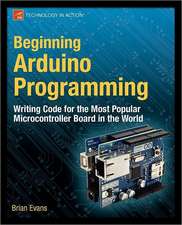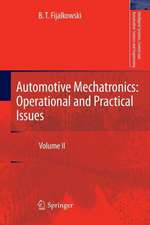Designing Embedded Systems with Arduino: A Fundamental Technology for Makers
Autor Tianhong Pan, Yi Zhuen Limba Engleză Hardback – 24 mai 2017
A simple step-by-step demonstration system accompanies you from vision to reality – and just like riding a bike, you’ll get better at it, the more you do it. Featuring a wealth of detailed diagrams and more than 50 fully functional examples, this book will help you get the most out of this versatile tool and bring your electronic inventions to life.
| Toate formatele și edițiile | Preț | Express |
|---|---|---|
| Paperback (1) | 942.13 lei 6-8 săpt. | |
| Springer Nature Singapore – 12 ian 2019 | 942.13 lei 6-8 săpt. | |
| Hardback (1) | 948.16 lei 6-8 săpt. | |
| Springer Nature Singapore – 24 mai 2017 | 948.16 lei 6-8 săpt. |
Preț: 948.16 lei
Preț vechi: 1156.29 lei
-18% Nou
Puncte Express: 1422
Preț estimativ în valută:
181.43€ • 189.94$ • 150.12£
181.43€ • 189.94$ • 150.12£
Carte tipărită la comandă
Livrare economică 05-19 aprilie
Preluare comenzi: 021 569.72.76
Specificații
ISBN-13: 9789811044175
ISBN-10: 9811044171
Pagini: 228
Ilustrații: XVI, 228 p. 139 illus., 103 illus. in color.
Dimensiuni: 155 x 235 x 16 mm
Greutate: 0.52 kg
Ediția:1st ed. 2018
Editura: Springer Nature Singapore
Colecția Springer
Locul publicării:Singapore, Singapore
ISBN-10: 9811044171
Pagini: 228
Ilustrații: XVI, 228 p. 139 illus., 103 illus. in color.
Dimensiuni: 155 x 235 x 16 mm
Greutate: 0.52 kg
Ediția:1st ed. 2018
Editura: Springer Nature Singapore
Colecția Springer
Locul publicării:Singapore, Singapore
Cuprins
Part 1 Basic Skill Training and Application.- Getting Started with Arduino.- The basic Functions.- Using Sensors with the Arduino.- Electromechanical Control using the Arduino.- Wireless Control using the Arduino.- Part 2: Case Studies.- Robot Moving using Line Tracking.- Robot Control using Bluetooth.- A Fire-fighting Robot.
Notă biografică
Tianhong Pan obtained his Ph.D. degree in April, 2007 from Shanghai Jiao Tong University, China. He then worked for 1.5 years at National Tsinghua University, Taiwan China since 2009, and 3.5 years at University of Alberta, Edmonton Canada since 2011 as a postdoctoral fellow, where gained valuable industrial experience in semiconductor manufacturing processes and petrochemical industry. Now, He has been a professor in School of Electrical and Information Engineering, Jiangsu University, Zhenjiang, China. As the core member of innovative research & education organization of Asia, he organized all Summer Program of Innovative Engineering Design since 2013 and got a good experience in “Embedded System Design using Arduino”. In addition to teaching Arduino, he enjoys automating everyday tasks, blinking LEDs, designing and etching PCBs, and lots of random things in between. Much of his time has been spent researching, building, and testing various controllers to make his device work automatically. Additionally, he published several articles in refereed journals and international conferences.
Yi Zhu received the Ph.D. degree in communication and information system from Nanjing University of Posts and Telecommunications, Nanjing, China, in 2016. He is currently an Associate Professor of School of Computer Science and Communication Engineering, Jiangsu University, Zhenjiang, China. Since 2010, he began to have interest in Innovative Engineering Education and Maker Training. As the core member of innovative research & education organization of Asia, he attended all Summer Program of Innovative Engineering Design and Creative Engineering Design Competition since 2013. In 2014 & 2015, he visited Yamaguchi University of Japan as visiting lecturer to teach “Embedded System”. These abroad education activities provided great valuable experiences for forming his education idea of maker training. Through teaching practice, he proposed an effective maker training mode based on “Arduino/Raspberry Pi/Android/Robot” in the end of 2015. For his contribution in maker education, he received the first prize of Teaching Achievement Award by Jiangsu University and the first prize of National Engineering Training by Ministry of Education institution of Engineering Training Guidance Committee respectively in 2016.
Textul de pe ultima copertă
In this DIY guide, you will learn how to use Arduino – the open-source hardware board for makers, hobbyists, and inventors. You will learn how to develop your own projects, create prototypes, and produce professional-quality embedded systems.
A simple step-by-step demonstration system accompanies you from vision to reality – and just like riding a bike, you’ll get better at it, the more you do it. Featuring a wealth of detailed diagrams and more than 50 fully functional examples, this book will help you get the most out of this versatile tool and bring your electronic inventions to life.
A simple step-by-step demonstration system accompanies you from vision to reality – and just like riding a bike, you’ll get better at it, the more you do it. Featuring a wealth of detailed diagrams and more than 50 fully functional examples, this book will help you get the most out of this versatile tool and bring your electronic inventions to life.
Caracteristici
Includes regular expressions usage in Arduino Provides over 50 fully functional examples of input/output connecting circuits for applying Arduino Offers an in-depth examination of complex and subtle electromechanical design using Arduino Features handy quick-reference tables to help readers with regular expression syntax Includes supplementary material: sn.pub/extras











